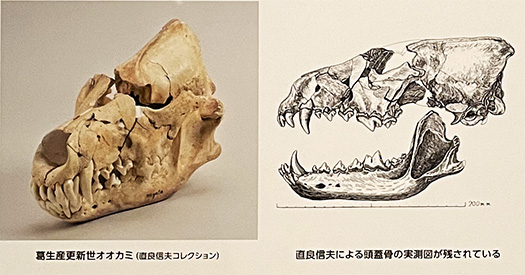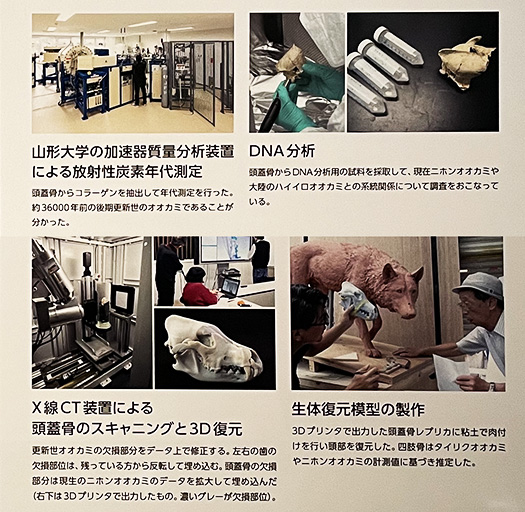


きのうのブログ記事ではわが家周辺でのサケ遡上ニュース篇。
加齢と共にどうもイキモノへの愛着が強くなってきています。
散歩では不思議とイヌに好かれるようになってきている。
こっちが動物愛護に目覚めてくるとかれらは敏感に察知して
「こいつはチョロい、すぐにメロメロ(笑)」と
籠絡に掛かってくるのだろうと被害妄想(笑)的な受け身心理ですが、
そういうのにだまされるのも、それはそれで楽しい。
わたしは小さいときにイヌに噛まれた経験があるので、
原体験的にはあまり好意は持っていないはずなのに・・・。
例のデジタル写真復元はまだ報告が寄せられません(泣)。
しかし既存のわたしのデータバックアップ環境からいくつかのデータ再発見。
そのなかに「国立歴史民俗博物館」(千葉県佐倉市)の展示撮影写真。
1981年の開館からすでに41年目ですが、わたしの大好きな博物館。
展示研究テーマ的にわたしのツボを押さえてくれるのですが、
それが感染症の影響拡大でやむを得ない閉館状況に陥ったところ、
むしろそれをチャンスにしてこれまでの展示内容を一新していた。
とくに石器時代から縄文、弥生という年代コーナーは
まったく目が覚めるほどの大変革を遂げていた。説明文によると
「AMS-炭素14年代に基づく高精度な較正暦年代を縄文・弥生時代を中心に適用」
して、大胆な再構成・展示革新を行っていたのです。
わたし的には「まだまだ生きて人類全史解明の行く末を見届けるぞ」
という強いモチベーションを抱かせてくれる(笑)。
いや、笑い事ではなく心の底から歓喜のこだまが湧き上がってくるのです。
考古的発掘に対してその年代特定が相当程度の正確度でできれば、
人類史の知見は大きく前進することになる。
ここでは37,000年前に日本列島に人類が出現し、
その後7世紀に古代国家「日本」が成立する時期までの
歴年代的に考古事実を分析した内容に即して展示構成されている。
よく言われる「文字記録」だけの歴史から跳躍した「先史」が探究される。
科学的最新知見による歴史の再構築といえるでしょう。
知る、という人間らしい営為の発掘力が加速されることになる。
どんな事実が解明されているのか、まさに興味津々。
知的興奮を覚えたオモシロポイントをいくつか取り上げてみたい。
前置きが長くなってしまいほぼ紙数が尽きてしまった(笑)。
その最初展示部分に、このオオカミ、イヌと人類のDNA的な科学解析。
「2017年から3年間、栃木県葛生から出土した36,000年前の
巨大オオカミ頭蓋骨について、歯の形態分析や年代測定、X線CT調査、
DNA解析などを行ってきた。・・・旧石器時代人が渡ってきた列島には
このような巨大オオカミが棲息していたのだ。・・・」との記述。
いきなり列島での人類痕跡と生物環境の時間的な特定事実。
一方、イヌは約700万年前ころにオオカミとは系統が分かれたとされる。
旧石器やその後の縄文の人々はイヌと共生していた痕跡もあるので、
このような巨大オオカミとは人といっしょに戦っていたのだろうか。
いきなり36,000年前からの歴史説き起こしだった。
列島で展開された「人類史」に科学的探究が及んできていることに感動。
English version⬇
Animal Observation Arc 2nd Human History and the Japanese Islands in 36,000 Years Ago
The photographic records of the National Museum of Japanese History were unearthed from the backup data. A ray of light in the exploration of my life’s work, “House and Human History”. …
In yesterday’s blog entry, I wrote about the news of the salmon run around my house.
As I age, I am becoming more and more attached to my canines.
When I go for a walk, I find that, strangely enough, dogs like me anyway.
As I become more and more aware of animal welfare, they are sensitive to it.
They are very sensitive to my animal love, and when I become aware of it
I am in a paranoid (laugh) and passive state of mind.
But it is fun to be deceived by them.
I was bitten by a canine when I was little.
I was bitten by a canine when I was a child, so I am not sure I have much fondness for them….
I have not received any reports of digital photo restoration yet.
However, I rediscovered some data from my existing data backup environment.
Among them are photos taken at the National Museum of Japanese History (Sakura City, Chiba Prefecture).
It has been 41 years since the museum opened in 1981, and it is my favorite museum.
It is my favorite museum, and it hits all the right spots for me in terms of exhibition and research themes.
When the museum was unavoidably closed due to the spread of infectious diseases, it was a good opportunity to renew the contents of the exhibits so far.
When the museum was forced to close due to the spread of infectious diseases, it took the opportunity to renew its exhibits.
In particular, the chronological section from the Stone Age to the Jomon and Yayoi periods
the chronological section from the Stone Age to the Jomon and Yayoi periods was completely transformed. According to the description
“The highly accurate calibrated calendar based on AMS-Carbon-14 dating has been applied mainly to the Jomon and Yayoi periods.
The museum had undergone a bold reorganization and innovation in its display.
In my opinion, the exhibition gave me a strong motivation to “live to see the end of the elucidation of the entire history of humankind.
I am still motivated to live to see the end of the elucidation of the entire history of mankind” (laugh).
No, it is not a laughing matter, but rather a joyful outpouring from the depths of my heart.
If we can determine the age of the archaeological excavation with a considerable degree of accuracy, our knowledge of human history will make great progress.
The knowledge of human history will be greatly advanced.
Here, we have the first evidence of the appearance of humans in the Japanese archipelago 37,000 years ago, followed by the appearance of the ancient nation of “Japan” in the 7th century.
The following is a chronological analysis of the archaeological facts
The exhibition is organized according to the chronological analysis of archaeological facts from 37,000 years ago to the establishment of the ancient nation of Japan in the 7th century.
This exhibition explores “prehistory,” a leap from the often-quoted history based solely on written records.
It can be said to be a reconstruction of history based on the latest scientific findings.
It will accelerate the excavation power of the humanistic activity of knowing.
It is truly intriguing to see what facts are being uncovered.
I would like to highlight some of the omoshiroi points that have aroused my intellectual excitement.
I have almost run out of paper space because of the lengthy preamble (laughs).
In the first part of the exhibit, this DNA-like scientific analysis of wolves, dogs, and humans.
“For three years starting in 2017, a 36,000-year-old
We have conducted portable analysis of teeth, dating, X-ray CT studies, and
DNA analysis, etc. have been conducted. …in the archipelago where Paleolithic man crossed over.
The Paleolithic man inhabited the archipelago. The description of the site is “The archipelago where Paleolithic man came from was inhabited by these giant wolves.
This is suddenly a time-specific fact of human traces and biological environment in the archipelago.
On the other hand, it is believed that the canine lineage separated from the wolf around 7 million years ago.
Since there are traces that Paleolithic and later Jomon people coexisted with canines
Did they fight with these giant wolves along with humans?
This was a sudden historical reconstruction from 36,000 years ago.
I was impressed by the fact that scientific exploration is now extending to the “human history” that has unfolded in the archipelago.
Posted on 9月 28th, 2022 by 三木 奎吾
Filed under: こちら発行人です, 歴史探訪







コメントを投稿
「※誹謗中傷や、悪意のある書き込み、営利目的などのコメントを防ぐために、投稿された全てのコメントは一時的に保留されますのでご了承ください。」
You must be logged in to post a comment.